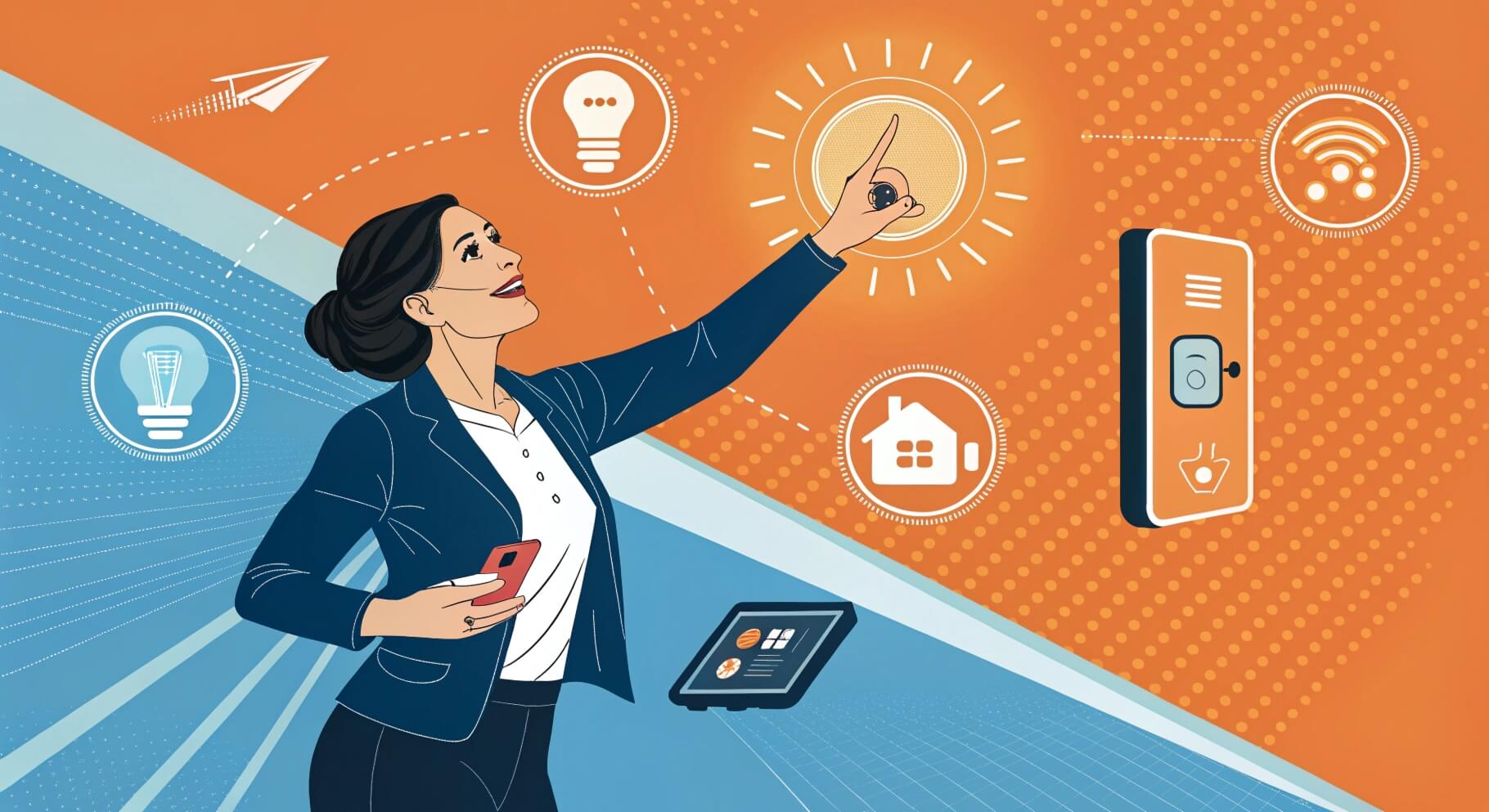The concept of smart home automation has evolved significantly over the past few decades, transforming the way we interact with our living spaces. At its core, smart home automation refers to the integration of technology into household systems, allowing for remote control and monitoring through various devices. This technological advancement has not only enhanced convenience but has also improved energy efficiency, security, and overall quality of life.
As the Internet of Things (IoT) continues to expand, more homeowners are embracing smart technologies, leading to a surge in the development of innovative products designed to streamline daily tasks. The appeal of smart home automation lies in its ability to create a seamless living environment. Homeowners can now control lighting, temperature, security systems, and even kitchen appliances from their smartphones or through voice commands.
This level of control not only simplifies everyday activities but also provides peace of mind, knowing that one can monitor their home from virtually anywhere. As we delve deeper into the various components of smart home automation, it becomes evident that these technologies are not merely luxuries but essential tools for modern living.
Key Takeaways
- Smart home automation is the integration of technology into the home to control and automate various systems and appliances.
- Automated lighting systems offer convenience, energy efficiency, and security benefits for homeowners.
- Smart thermostat control allows for remote temperature adjustments and energy savings through personalized scheduling.
- Automated security systems provide peace of mind with features like motion detection, surveillance cameras, and remote monitoring.
- Voice-activated virtual assistants like Amazon Alexa and Google Assistant offer hands-free control of smart home devices and information access.
- Smart home entertainment systems provide seamless integration of audio and video devices for a more immersive experience.
- Automated kitchen appliances offer convenience and efficiency through features like remote monitoring and control.
- Embracing smart home automation can enhance convenience, comfort, and security while also promoting energy efficiency and cost savings.
1. Automated Lighting Systems
Automated lighting systems represent one of the most popular facets of smart home technology. These systems allow homeowners to control their lighting remotely, set schedules, and even adjust brightness levels based on the time of day or occupancy. For instance, smart bulbs can be programmed to turn on at sunset and off at sunrise, ensuring that homes are well-lit when needed while conserving energy during daylight hours.
Additionally, many automated lighting systems can be integrated with motion sensors, which detect movement and activate lights accordingly. This feature is particularly useful for enhancing security, as it can deter potential intruders by creating the illusion of an occupied home. Moreover, automated lighting systems often come with customizable settings that cater to individual preferences.
Homeowners can create different lighting scenes for various activities—such as reading, watching movies, or hosting dinner parties—by adjusting the color temperature and intensity of the lights. Advanced systems even allow for integration with other smart devices; for example, when a homeowner activates their home theater system, the lights can automatically dim to create an immersive viewing experience. This level of personalization not only enhances comfort but also contributes to energy savings by ensuring that lights are only used when necessary.
2. Smart Thermostat Control

Smart thermostats have revolutionized the way we manage heating and cooling in our homes. Unlike traditional thermostats that require manual adjustments, smart thermostats learn from user behavior and automatically adjust settings to optimize comfort and energy efficiency. For example, a smart thermostat can track when residents are typically home or away and adjust the temperature accordingly.
This feature not only ensures a comfortable environment but also significantly reduces energy consumption by preventing heating or cooling when it is unnecessary. Many smart thermostats are equipped with advanced features such as geofencing technology, which uses the location of a homeowner’s smartphone to determine whether they are at home or away. When the last person leaves the house, the thermostat can automatically switch to an energy-saving mode, and when someone is on their way back, it can begin to heat or cool the home in preparation for their arrival.
Additionally, these devices often provide detailed energy usage reports, allowing homeowners to track their consumption patterns and make informed decisions about their heating and cooling habits. This data-driven approach not only promotes energy efficiency but also contributes to cost savings on utility bills.
3. Automated Security Systems
The rise of automated security systems has transformed home safety into a more accessible and manageable aspect of modern living. These systems typically include a combination of surveillance cameras, motion detectors, door/window sensors, and alarms that can be monitored remotely via smartphones or tablets. Homeowners can receive real-time alerts about suspicious activity or breaches in security, allowing them to respond promptly regardless of their location.
For instance, if a motion sensor detects movement in the yard while the homeowner is away, they can receive an instant notification and view live footage from their security cameras. Furthermore, many automated security systems offer features such as smart locks that allow homeowners to control access to their property remotely. With these locks, individuals can grant temporary access to guests or service providers without needing to be physically present.
This capability is particularly beneficial for those who travel frequently or have busy schedules. Additionally, some systems integrate with voice-activated virtual assistants, enabling users to lock doors or check security status using simple voice commands. The combination of these technologies not only enhances security but also provides homeowners with greater control over their living environment.
4. Voice-Activated Virtual Assistants
Voice-activated virtual assistants have become integral components of smart home automation, serving as central hubs for controlling various devices and systems within the home. These assistants—such as Amazon Alexa, Google Assistant, and Apple Siri—allow users to interact with their smart devices using natural language commands. For example, a homeowner can simply say, “Turn on the living room lights,” or “Set the thermostat to 72 degrees,” and the assistant will execute the command without requiring any manual input.
The versatility of voice-activated virtual assistants extends beyond simple commands; they can also facilitate complex routines that involve multiple devices. For instance, a user might create a “Good Night” routine that turns off all lights, locks the doors, and sets the thermostat to a comfortable sleeping temperature with a single voice command. This level of integration not only enhances convenience but also encourages users to engage more fully with their smart home technologies.
Additionally, these assistants often support third-party applications and services, allowing homeowners to expand their smart home ecosystem further by integrating additional functionalities such as music streaming or calendar management.
5. Smart Home Entertainment Systems

Smart home entertainment systems have redefined how we consume media in our homes. These systems encompass a range of devices including smart TVs, streaming devices, sound systems, and even projectors that can be controlled through a single interface or app. With the rise of streaming services like Netflix, Hulu, and Disney+, homeowners can access a vast library of content at their fingertips without needing physical media.
Smart TVs often come equipped with built-in apps that allow users to stream directly without additional hardware. Moreover, smart entertainment systems can be integrated with voice-activated virtual assistants for hands-free control. Users can ask their assistant to play specific shows or movies, adjust volume levels, or switch between different input sources without needing to navigate through menus manually.
This seamless integration enhances the viewing experience by making it more intuitive and user-friendly. Additionally, multi-room audio systems allow homeowners to enjoy music throughout their living spaces by synchronizing sound across different rooms or zones. This capability is particularly appealing for hosting gatherings or simply enjoying music while moving around the house.
6. Automated Kitchen Appliances
The kitchen has become a focal point for smart home automation with the introduction of automated kitchen appliances designed to simplify cooking and meal preparation. Smart refrigerators now come equipped with features such as touch screens that display recipes, inventory management systems that track food items and expiration dates, and even cameras that allow users to see inside their fridge remotely via smartphone apps. This level of connectivity helps reduce food waste by reminding homeowners when items are nearing expiration and suggesting recipes based on available ingredients.
In addition to refrigerators, other kitchen appliances such as ovens, coffee makers, and dishwashers have also embraced automation. Smart ovens can be preheated remotely or programmed to cook meals at specific times based on user preferences. For example, a homeowner could set their oven to start cooking dinner while they are still at work so that it is ready upon their arrival home.
Similarly, smart coffee makers allow users to schedule brewing times or control settings through mobile apps or voice commands. These innovations not only enhance convenience but also encourage healthier eating habits by making meal preparation more efficient.
Embracing Smart Home Automations
As we navigate through an increasingly digital world, embracing smart home automation offers numerous benefits that enhance our daily lives. From automated lighting systems that adapt to our routines to advanced security measures that provide peace of mind, these technologies are reshaping how we interact with our homes. The integration of voice-activated virtual assistants further simplifies control over various devices while promoting a more connected lifestyle.
The evolution of smart home technology continues to accelerate as new innovations emerge regularly. Homeowners who invest in these systems not only enjoy greater convenience but also contribute to energy efficiency and sustainability efforts by optimizing resource usage within their homes. As we look toward the future, it is clear that smart home automation will play an increasingly vital role in shaping our living environments and enhancing our overall quality of life.
If you’re looking to save time and make your life easier with smart home automations, you may also be interested in learning about how moms are making money on Etsy in 2025. This article explores the various ways in which mothers are leveraging their creativity and entrepreneurial spirit to generate income from the comfort of their homes. By combining smart home technology with a side hustle like selling handmade goods on Etsy, you can maximize your time and financial resources.
FAQs
What are smart home automations?
Smart home automations are pre-programmed settings that allow your smart home devices to work together to perform tasks automatically. These tasks can range from turning on lights at a certain time to adjusting the thermostat based on your schedule.
What are the benefits of smart home automations?
Smart home automations can save you time and effort by taking care of routine tasks for you. They can also help you save energy and money by optimizing the use of your smart home devices.
What are some examples of smart home automations?
Some examples of smart home automations include setting up a “goodnight” routine that turns off all the lights and locks the doors, creating a “welcome home” routine that adjusts the thermostat and turns on the lights when you arrive, and scheduling the coffee maker to start brewing in the morning.
How do smart home automations save time?
Smart home automations save time by eliminating the need for you to manually control your smart home devices. Instead of adjusting each device individually, you can set up automations to handle multiple tasks at once.
What are some must-have smart home automations that can save time?
Some must-have smart home automations that can save time include setting up a morning routine to turn on lights and start the coffee maker, creating a “vacation” mode to simulate occupancy while you’re away, and scheduling the thermostat to adjust based on your daily routine.

